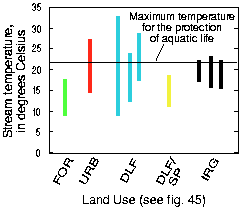Water Quality in the Central Columbia Plateau, Washington and Idaho, 1992-95
Table of contents || Previous section || Next section || Glossary
Land use influences both the chemical and physical characteristics of streams, thereby affecting aquatic life. Assessing the relative importance of potential impacts to streams helps water resource managers allocate resources to better protect and manage streams. Most impacts on streams in the Central Columbia Plateau result from agricultural practices such as fertilizer and pesticide application and sediment from agricultural runoff. While grazing was more pervasive historically, it still occurs in localized areas and therefore influences riparian and instream habitat, especially in the North-Central subunit. The dominant impact from urban land use is point source discharge of nutrient-rich, treated wastewater from wastewater-treatment plants; however, urban impacts are overall less significant than agricultural impacts. Biological communities, including fish, that presently reside in streams of the Central Columbia Plateau are influenced by cumulative impacts from all these land use activities and are therefore influenced by three of the dominant water resource issues: eutrophication from excessive nutrient inputs, physical habitat alteration, and pesticides.
Eutrophication is a natural process which can be accelerated by human activities that increase inputs of nutrients, primarily nitrogen and phosphorus, to surface waters, thereby causing excessive growth of aquatic plants. This overgrowth causes a wide swing in oxygen concentrations over a 24-hour period; because of respiration and decay night-time oxygen can decrease to levels that will not sustain some aquatic life. Aquatic plant growth also alters physical habitat by slowing the flow of water and reducing sunlight penetration.
This eutrophication cycle has occurred in the wastewater-dominated South Fork of the Palouse River (fig. 38). This overgrowth resulted in dissolved oxygen concentrations decreasing below the level (5 mg/L) required for many fish species (fig. 42) [34].

Figure 42. Dissolved oxygen concentrations decreased at night at three sites on the Palouse River; the decrease was greatest in the wastewater-dominated stream.
Oxygen also decreased in the dryland streams, but the decrease was less severe: the dryland reach has less plant growth than the wastewater-dominated reach. The Palouse River at Hooper, a site affected by a combination of both dryland farming and urban land uses, had dissolved oxygen concentrations that remained at or above the 5 mg/L level for sustaining fish.
Concentrations of nitrogen during the growing season were highest in the irrigated and urban land use and lowest in the forest and dryland farming/spring sites (fig. 36). The dryland sites were intermediate in nitrogen concentrations.
Understanding the relation between algae and nutrients is important for the development of integrated water- quality assessment and monitoring programs. Along with influencing dissolved oxygen in surface waters, individual species of algae respond to specific nutrient conditions and therefore serve as indicators of water quality. Indicator species can be either positively or negatively correlated with nutrient concentrations.
In streams where nutrient concentrations are low, such as in the forested land use, nutrient-poor species dominated (fig. 43); because these algae fix their own nitrogen, high nutrient levels need not be present in their environment. A dominance of nutrient-rich algae, as documented in the urban land use stream that has high inputs of nutrients during summer, indicates a high concentration of nutrients.

Figure 43. Algal communities in the forested land use streams (FOR) were dominated by nutrient-poor species, most of which were blue-green algae, while the urban stream (URB) was dominated by nutrient-rich species. Communities varied in streams in the dryland and irrigated land uses (DLF, DLF/SP, and IRG), but nutrient-rich species dominated. (Percentages do not add up to 100 because many algal species are not correlated with nutrient concentrations.)
In the Central Columbia Plateau, agriculture, grazing, and urban practices have singly, or in combination, impaired the riparian vegetation and bank stability, and have increased sediment erosion (p. 14), thereby affecting instream habitat.
Historically, much of the land in the Central Columbia Plateau was dominated by grasslands with an established riparian community, which maintained cooler water temperatures, provided food and cover for fish, and stabilized stream banks. Vegetated banks commonly have less bank erosion [35]. Current conditions, however, are greatly altered. Most streams lack a riparian community; average canopy cover is less than 20 percent, with most of this in isolated reaches. There is also substantial bank erosion (about 70 percent), which may be partially due to the reduction of riparian vegetation and agricultural practices [35].
Lack of a riparian community results in higher water temperatures (fig. 44); temperatures in urban and dryland streams in the Palouse subunit exceed levels that protect aquatic life (22 degrees Celsius) [34]. These higher temperatures may partially explain the lack of rainbow trout, which were historically present [36].

Figure 44. Stream temperature ranges in August 1994 and 1995 show that temperatures in urban (URB) and dryland (DLF) streams in the Palouse subunit exceed levels for protection of aquatic life (22 degrees Celsius).
Organochlorine pesticides, most of which are banned in the U.S., are stored in streambed sediment and fatty tissue in fish. Some of these compounds were found at concentrations that may be detrimental to aquatic life. This is particularly true for p,p'-DDE in streambed sediments (p. 14) and fish tissue [25, 27].
Modern pesticides are more water-soluble and therefore less prone to be stored in sediment or accumulate in fish tissue. Concentrations in surface waters only occasionally exceed freshwater-chronic criteria (see p. 12, 26). However, regardless of criteria, these pesticides may influence aquatic life. For example, carp collected from Royal Lake within the Columbia Basin Irrigation Project had reduced concentrations of an important nervous system enzyme in their brains [37]. Organophosphate pesticides, which are used in the Central Columbia Plateau and were detected, are known to cause this effect. While the implications for sportfish are unclear, this finding indicates that modern pesticides may have a negative influence on some fish species.
Fish communities reflect cumulative effects of land use activities. Streams in the Palouse subunit, which once contained rainbow trout, are presently dominated by minnows (fig. 45). These streams have been impacted by elevated stream temperatures, extensive soil erosion from both agricultural runoff and bank destabilization, and reduced oxygen levels caused by eutrophication. The spring-fed Crab Creek in the North-Central subunit is able to sustain rainbow trout, likely due to cooler water temperatures and better water quality. Fish communities in the irrigated Quincy-Pasco subunit vary because of the diversity of stream conditions. Even with little riparian shading, stream temperatures remain low as a result of the input of cold irrigation water from the Columbia River. Furthermore, fish communities in the irrigation streams may be influenced by lakes downstream. Pesticides may also have an effect on fish species (p. 12, 14).
Figure 45. Composition of fish communities in various land uses. Minnows and sculpin are the dominant species.